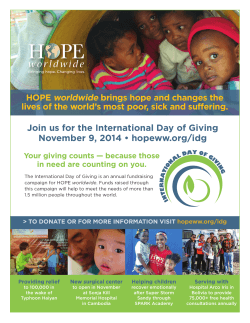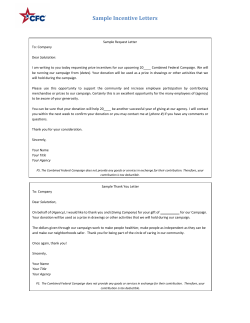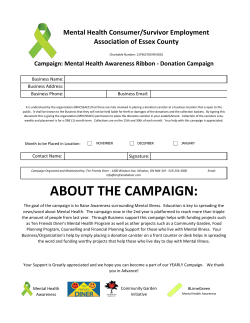
Conference Report - Stanford University
Reforming Lobbying and Campaign Finance Introduction On November 14-‐15, 2014, the Program on American Democracy in Comparative Perspective at Stanford University hosted a conference on lobbying and campaign finance. The conference brought together scholars, lawyers, and practitioners to understand the impact of money in politics on a variety of outcomes, including regulatory capture, polarization, and inequality. The conference showcased and evaluated recent empirical findings on lobbying in an effort to discuss solutions to problems associated with lobbying and campaign finance. Lobbying and campaign finance reform are two topics of greatest frustration and disappointment for the reform community. Decades of reform efforts have yielded mixed results, and empirical research is ambivalent about the effect that contributions and expenditures have on policy outcomes. Meanwhile, the cost of election campaigns at the national, state, and local levels has grown exponentially. Lobbying activity has also increased in regulatory and legislative policymaking. The conference asked if developments in lobbying and campaign finance have distorted policy outcomes and the representative process. The conference also included reformers from the international community to understand how other countries might be better equipped to limit disproportionate influence in the policymaking process. This report summarizes the key reform ideas from the conference, which include increasing soft money to political parties, disclosure of dark money, limiting lobbying access through the revolving door, and increasing the capacity of government. Soft Money to Parties One of the primary concerns with campaign finance is the question of who has influence in election campaigns. While federal law limits the amount that individuals and political action committees (PACs) can donate to specific campaigns, patterns of campaign finance show that 1 wealthy individuals and corporations are much more likely to donate than average citizens. Further, following Citizens United vs. Federal Election Commission (2010), which lifted bans on corporate spending in campaigns, scholars and observers have become more worried about the disproportionate influence that corporations, unions, and nonprofit organizations can exert in elections. Debates about how to structure the campaign finance system have long turned on the influence of small donors versus large donors. Evidence from the past few years shows that large donors per se are not the problem, but rather, the way the money gets aggregated and distributed. Political parties used to have much more control over money donated to campaigns by individuals and PACs. They could use these funds (“soft money”) for party activities, such as voter mobilization and issue advertising. The Bipartisan Campaign Finance Reform Act of 2002 (BCRA), which amended the Federal Election Campaign Act of 1971, limited the way parties could spend soft money. As a result, parties play a less significant role in aggregating money. Candidates appeal directly to individual donors and PACs for campaign support. Why might the current campaign finance regime exacerbate, or potentially even cause, political polarization? Empirical evidence indicates that small and large donors tend to be more ideologically extreme than political parties. As a result, individual candidates have taken on increasingly radical positions in campaigns, which translates into less moderate legislative activity. In a study of state-‐level campaign finance laws, Ray La Raja finds that in states where there are no limits on party contributions, state legislatures are less polarized than in states that limit party contributions. Outside groups devoted to special interests or narrow ideological positions now wield enormous influence not only in campaigns, but also in party functions such as mobilizing voters and setting the legislative agenda. We therefore recommend channeling money through parties, perhaps through increasing limits to party organizations or allocating donations through party leadership. We prefer to strengthen parties rather than limit corporate and PAC contributions for a few reasons. Adam Bonica shows that fears of excessive corporate spending after Citizens United have not come to pass – corporations spend money on federal lobbying, but have not greatly increased their independent expenditures in elections. Further, corporate giving tends to be bipartisan and politically strategic. Giving by corporate elites (CEOs and board members), on the other hand, tends to be partisan and ideologically driven. Similarly, Michael Barber finds that while PACs value access, giving money equally to both parties, individual donors tend to be more ideologically extreme. In states with higher limits for individual contributions, legislators tend to be more extreme than in states with higher limits for PAC contributions. When candidates need to appeal directly to individual donors for money, there is evidence that they take more radical positions than when they appeal to traditional organizations such as parties and PACs. But when parties aggregate and distribute campaign funds, they have an interest in backing moderate candidates. Richard Pildes argues that party fragmentation, as evidenced by the rise of tertiary organizations and the diffusion of power to personalistic candidates within parties, has contributed greatly to polarization. 2 Disclosure of Dark Money Although patterns of corporate and PAC giving show that many business groups tend to be strategic, rather than ideological, in their political donations, there are many forms of campaign spending that are not transparent. Individual expenditures that do not go directly to campaigns, even when spent on behalf of a candidate or policy, do not have to be disclosed. Neither does corporate spending to non-‐profit organizations or groups that are not explicit political committees. Organizations that do not coordinate activities with specific candidates can raise and spend unlimited amounts. Nonprofit groups that are politically active, such as 501(c)(4)s, can also receive unlimited contributions from corporations and individuals without having to disclose them. It is therefore impossible to trace so-‐called “dark money,” and to rigorously assess the impact of various types of spending in elections. Therefore, in addition to strengthening party control over campaign resources, we also recommend disclosure laws for the political nonprofits and Super PACs that increasingly wield disproportionate influence in elections. In the 2014 midterm elections, outside groups often outspent candidates, particularly in high-‐profile contested races. Outside groups also get heavily involved in primary elections; radical candidates with outside support have successfully ousted many party moderates. The combination of transparency of dark money and strengthening parties might have an impact on polarization. Ben Ginsberg and Bob Bauer, both seasoned campaign lawyers, argue that when parties have more control over funding and nominations, they tend to choose moderates. However, there is a debate about the impact that strengthening parties would have. Prior to the passage of BCRA, academics and commentators noted that parties were conduits of access for special interests and wealthy individuals. Tom Mann’s research shows that parties may be just as likely to seek ideologically extreme funding sources, and to choose less radical candidates. Ongoing research shows that party donors, who tend to be much wealthier than non-‐donors, have preferences that diverge significantly from those of non-‐donors.1 Therefore, parties may remain polarized even if they aggregate funds. Further, there are many causes of contemporary political polarization. The impact of single political reforms on polarization may therefore be attenuated or minimal. Revolving Door and Lobbying Access Lobbying refers to the process of influencing legislation. Just as campaign finance expenditures have risen, so too has lobbying activity. Lee Drutman estimates that there are now 12,000-‐14,000 registered lobbying organizations in Washington, DC. The top tier of lobbying organizations – 1 Larry Bartels, 2010, Unequal Democracy: the Political Economy of the New Gilded Age, Princeton University Press; Benjamin Page and Martin Gilens, 2014, “Testing Theories of American Politics: Elites, Interest Groups, and Average Citizens,” Perspectives on Politics 12(3): 564-‐581; Benjamin Page, Larry Bartels, and Jason Seawright, 2013, “Democracy and the Policy Preferences of Wealthy Americans,” Perspectives on Politics 11(1): 51-‐73; Jacob Hacker and Paul Pierson, 2011, Winner-‐Take-‐All Politics: How Washington Made the Rich Richer—and turned its back on the Middle Class, Simon & Schuster. 3 about a third of all lobbying – spends more than $4.9 million on lobbying activity, and 90% of this tier is composed of business and corporate interests. Drutman therefore calculates a “countervailing power ratio” of 34-‐to-‐1 – in other words, corporate interests wield significantly disproportionate power in lobbying. There is a widespread perception that lobbying activities are both corrupt, and biased towards monied interests. The Gallup poll, in its survey of honesty and professional ethics, finds that lobbyists are consistently the lowest-‐ranked profession in the United States.2 Empirically, however, there is little link between lobbying and quid pro quo corruption, and evidence on the impact of lobbying on policy outcomes has been mixed. Beth Leech noted that 37% of lobbying organizations with a full-‐time presence in Washington give only $1 in campaign contributions. Meta-‐analyses of lobbying studies show that lobbying groups do not always get what they want in Congress, and interests group achieve their desired outcome less than half the time. While less is known about lobbying influence in administrative agencies, an analysis of regulatory rule-‐making by Susan Webb-‐Yackee showed that lobbying the President’s Office of Management and Budget (OMB) was correlated with more rule-‐changes, particularly when the lobbying was undertaken by industry groups with expertise. Scholarly work does consistently demonstrate that lobbying provides significant access for interest groups, particularly through the revolving door. Through alliances with elected officials and government staff, lobbyists provide information, act as mediators, and draft talking points and legislation. Beth Leech and Rick Hall noted that lobbyists have tremendous power to shape the legislative agenda and to direct attention to specific policies. In an analysis of lobbying organizations and wealth, Beth Leech found that wealth alone was not a predictor of winning on a given issue, but the wealthy were much more likely to win when they had high-‐level government allies. Rather than recommend limits on lobbying, we instead recommend transparency in the career trajectories of government staff and lobbying organizations. Many staffers transition from jobs in government to lucrative work in which their government contacts are highly valued. Rick Hall’s empirical work shows that contacts to former government employers strongly predicts a lobbying organization’s chance of getting issue-‐specific provisions into legislation, and of keeping out provisions that it does not want. We also recommend transparency in the requests that lobbyists make of legislators. Data about access points between lobbyists and Congressional or administrative staff, and particularly about the specific requests that lobbyists make, is difficult to come by. Requiring that requests be made public might lead to better analysis and accountability of lobbying activity. Increase the Capacity of Government 2 http://www.gallup.com/poll/166298/honesty-‐ethics-‐rating-‐clergy-‐slides-‐new-‐low.aspx; http://www.gallup.com/poll/147026/Americans-‐Decry-‐Power-‐Lobbyists-‐Corporations-‐Banks-‐Feds.aspx 4 Legislators, bureaucrats, and their staff rely heavily on lobbyists and insiders for information and policy recommendations. This is not the case simply because of money and influence. The technical capacity and expertise of government offices and agencies has also declined. As legislation and regulation have become more complex, they create new opportunities for lobbyists to intervene in policymaking. Furthermore, there has been a decline in the number of government workers that makes legislative and administrative staffers dependent on lobbyists for information. The number of government workers is now lower than it was in the 1970s.3 Francis Fukuyama finds that the effect of the decline in government capacity is tremendous: it reduces effective governance, leads to legislative gridlock rather than negotiation, and makes the government more vulnerable to highly-‐organized and well-‐funded interests. Although libertarians and some conservatives criticize the excessive growth of the federal government, government capacity remains limited. The expansion of government services has not entailed an expansion of federal capacity, but instead has enhanced reliance on private, nonprofit, and state and local organizations. Delegation and contracting to third parties has undermined the capacity of government, making monitoring and accountability extremely difficult. Conclusion There is a thriving research agenda in the field of lobbying and campaign finance, and while empirical findings show some worrisome relationships between money, access, and political power, they also show how various reforms can mitigate these effects. Our policy recommendations come with a hefty dose of caution. While they are based on rigorous research, reforms always carry the risk of unintended consequences and are rarely implemented in predictable ways. The reform community should better establish the normative goals of reforms and weigh them against practical considerations, such as feasibility. Further research is needed to understand the extent to which these recommendations can mitigate trends in polarization and governance. Can parties moderate the ideological extremism of wealthy donors, or successfully mobilize more moderate portions of the electorate? Can a political coalition come together to devise and implement a new Pendleton Act, and if so, who would be part of the coalition? Can parties obviate outside groups (and their stream of TV advertisements) to mobilize voters at the grassroots level, or has technological innovation fundamentally changed how voters interact with the electoral process? Our recommendations are a first step towards improving the status quo, although we need further research and dialogue to move towards a more complete reform agenda. 3 John DiIulio, 2014, Bring Back the Bureaucrats: Why More Federal Workers Will Lead to Better (and Smaller!) Government, Templeton Press. 5
© Copyright 2025











